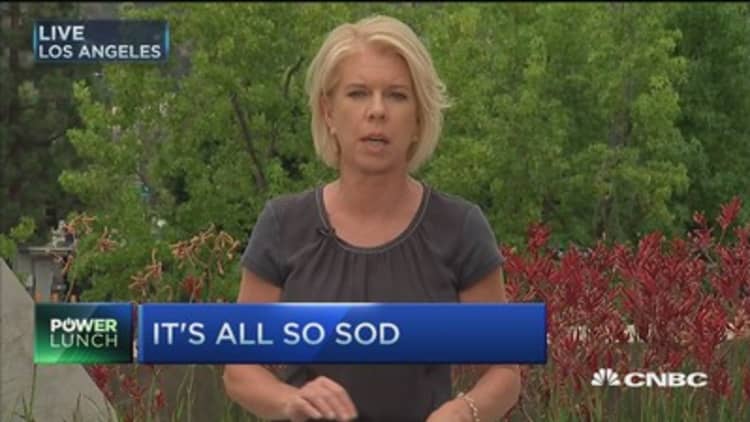
Suburbia was built on sod.
The post-World War II housing boom in California saw row after row of tract homes pop up with lawns in front and back. This is a region of the country where you need your lawn mowed every week, where grass feels cool under your feet in August, and where it's always been a cheap way to fill a yard.
Not anymore.
As Gov. Jerry Brown ordered 25 percent water reductions, Californians are responding by pulling out their grass, especially since there are rebates of $2 to $3 per square foot for doing so.
It's a sod story for those who grow turf, sell it and mow it.
"We laid off 30 people last Friday, probably the toughest thing I've ever done," said Jurgen Gramckow, who runs Southland Sod Farms, the largest grower of sod in the Los Angeles area. Business is down 50 percent from last year, and last year was down 50 percent from prerecession peaks.
This factors into sales at local nurseries.
"May should have been the best month we've had in 10 years, and it just wasn't so," said Carl Brodock of Elegant Gardens Nursery in Moorpark, California. He said his business was just recovering from the housing collapse. Then in April, the state ordered cuts to water use. Sod sales have dropped off 30 percent. "The color sales are way down as well. People aren't planting the petunias or the marigolds because they take too much water."
Neither Home Depot nor Lowe's would discuss exact figures on sod sales in California, but both highlighted that customers are coming in to buy other products.
"We have expanded our selection and availability of turf alternatives," said Home Depot spokeswoman Kathyn Emery. "In addition, our assortment of high-efficiency toilets is among the best in the industry. We have increased inventory to ensure we have enough product in the pipeline to support the demand."
"Customers have started looking at other landscaping options like drip irrigation, mulch and landscape rock," said Tara Gudger a spokeswoman for Lowe's. "Hoses for target watering outdoor live goods have also been popular."
Read MoreCompany shames you into using less water
Gardeners like Jesus Moreno are finding plenty of work tearing out lawns and putting in new irrigation systems and drought-tolerant plants.
But after that's done, will customers still need a gardener every week? He's hopeful: "It's forced us to really educate ourselves on the industry, the industry technology, in order to help our customers."
Gramckow, who sells sod, thinks grass is getting a bad rap.
"Sod converts CO2 to oxygen, it cools your environment, it sequesters carbon, it does a lot of things that 'bark and bushes' don't do," he said. Gramckow believes the drought won't last forever, and people will regret tearing out their yards. "I think when all that ends and people go back to their preferences, they'll go back to lawns."
—CNBC's Sofia Goode and Priscilla Casper contributed to this report.
—By CNBC's Jane Wells. Follow her on Twitter: @janewells


